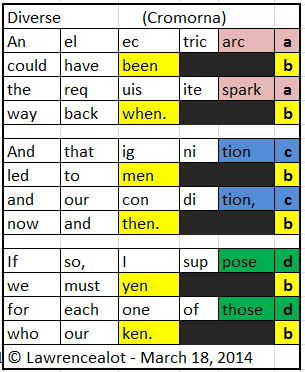This form started as a
nonce form written by
Michael
Fantina, aka Eusebius of Alllpoetry for his poem
"Magics"
Michael is
much too busy writing beautiful and entertaining poetry to be bothered with the
practice of giving names to forms which he writes on the fly, often consciously
or subconsciously influenced by Algernon Swinburne, from whom he thinks he
might have borrowed this pattern.
Definitely he was influenced to occasionally merge two un-stressed
syllables, or to add an occasional syllable deviating from a strict syllabic or
accentual pattern where his creativity and mind's ears says that it works.
Neither
was Swinburne the only great to invoke this technique. In fact is it is hard to find truly creative
and expressive poets where this technique has not sometime found deployment.
I have
been just learning to conform to form and pattern, and like anyone just
learning, have always felt safer abiding strictly to the defined pattern of a
form.
I define
and name each new form that I see (and/or like in any manner at all) so that we
may speak of it by name and all be speaking of the same animal when we give it
a try.
My specifications:
This is a stanzaic poem, consisting of one or more
sestets.
It is syllabic, each stanza being 10/10/6/5 syllables.
Rhymes: aabcbc, where the b-rhymes are feminine.
Metered subject to the following pattern:
DUM da da DUM da da DUM da da DUM
DUM da da DUM da da DUM da da DUM
da DUM da da DUM da
da DUM da da DUM
da DUM da da DUM da
da DUM da da DUM
Note: if you write this same form beginning each of
the long lines with a Spondee as did Gary Kent Spain, writing as venicebard on
Allpoetry, you will have written a Spondiddle.
Original poem Magics
by Eusebius
Gather the stars and
the moon for a spell,
With holly and sard
and an umber conch shell.
And sing to the
sound of
A bell left unrung.
With a pestle ground
love
Till your song is
re-sung.
Call on a harlot
who’s pale as the moon,
Call on her nightly,
but call on her soon.
And while she is
weeping,
Take one crystal
tear,
And when she is
sleeping
One jewel from her
ear.
Gather them there
near your hearth at the dawn,
Drench them with dew
from the grass on the lawn,
And while it is
brewing
Like some frothing
sea,
You’ll soon then be
wooing,
But me, only me!
© February 2014
You will see that
the above poem, and the one illustrated by the visual template below, stray
occasionally from the specified pattern.
That is what I refer
to a creative diddling around, and led me to the name of this form.
This represents a
step forward in my poetic growth, as my rigidity is lessened for I realize now
that poets always have this license, but can never take a knock for exercising
it in competition with this form.
My example poem:
Sweet
Apparition (Trochadiddle)
Watched as the moon
and the clouds seem to pose
with stars bunched
so closely the Milky Way glows,
with night now
becoming
invitingly cool
I heard something
coming
up out of the pool.
She's an apparition
it seems at first glance
formed with
perfection and sure to entrance.
Her eyes are green
emeralds
but tinted with blue
her voice sweetly
heralds
sweet pleasure, I
knew.
"Love me
tonight while we're here all alone,
I cannot stay for
this form is on loan."
I did I'm believing,
I slaked both our
thirst
and she's not now
grieving-
relieved of her
curse.
© Lawrencealot -
February 26, 2014
I call this a
Trochadiddle
Long lines begin
with a trochee and end with an iamb.
You will note that
in line 2, I added an unstressed
Syllable before
beginning the pattern - and also added an extra unstressed syllable mid-line,
as I did elsewhere. This is the diddling!
So the stressed
syllables become
STARS, CLOSE, MILK,
GLOWS, as though "with" were on line1.
Visual Template












